Belarus
| | This section needs expansion. You can help by adding to it. (September 2023) |
Below is a partial list of selected villages and towns(shtetls)depopulated of Jews during the Holocaust . The liquidation actions were carried out mostly by the Nazi Einsatzgruppen and Order Police battalions as well as auxiliary police through mass killings. The German "pacification" units of the Einsatzkommando were paramilitary forces within the Schutzstaffel, under the high command of the Obergruppenführer. The Einsatzgruppen operated primarily in the years 1941–45.
The towns and villages are listed by country, as follows:
| | This section needs expansion. You can help by adding to it. (September 2023) |
The following Jewish communities in Hungary were either partially or completely destroyed during the Holocaust. [1] [2]
Jewish communities in the following Latvian cities, towns and villages were destroyed during the Holocaust: [3]
The following Jewish communities in Lithuania were destroyed during the Holocaust. Note that the list includes places in modern, post-1991 Lithuania, some of which were in German-occupied Poland during the war. [4] [5] [6] [7]
| | This section needs expansion. You can help by adding to it. (February 2021) |
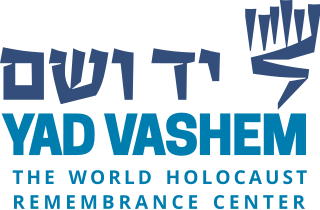
Yad Vashem is Israel's official memorial to the victims of the Holocaust. It is dedicated to preserving the memory of the Jews who were murdered; echoing the stories of the survivors; honoring Jews who fought against their Nazi oppressors and gentiles who selflessly aided Jews in need; and researching the phenomenon of the Holocaust in particular and genocide in general, with the aim of avoiding such events in the future. Yad Vashem's vision, as stated on its website, is: "To lead the documentation, research, education and commemoration of the Holocaust, and to convey the chronicles of this singular Jewish and human event to every person in Israel, to the Jewish people, and to every significant and relevant audience worldwide."
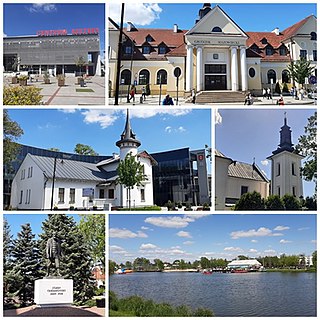
Grodzisk Mazowiecki is a town in central Poland, the capital of Grodzisk Mazowiecki County in the Masovian Voivodeship, with 29,363 inhabitants (2011). It is 30 kilometres (19 mi) southwest of Warsaw.
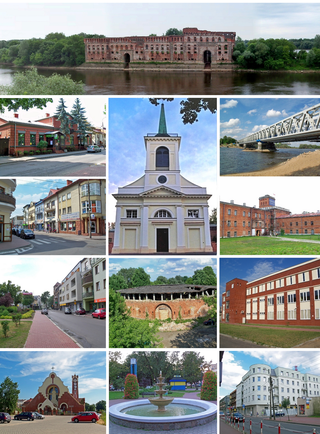
Nowy Dwór Mazowiecki, often simply referred to as Nowy Dwór, is a town in east-central Poland with ca. 42500 inhabitants (2008). It is situated in the Masovian Voivodeship ; previously, it was in Warszawa Voivodeship (1975–1998). It is the capital of Nowy Dwór County.

Międzyrzec Podlaski is a city in Biała Podlaska County, Lublin Voivodeship, Poland, with the population of 17,162 inhabitants as of 2006. The total area of the city is 20.03 square kilometres (7.73 sq mi). Międzyrzec is located near the Krzna river, not far from the border with Belarus.

Slutsk is a town in Minsk Region, Belarus. It serves as the administrative center of Slutsk District, and is located on the Sluch River 105 km (65 mi) south of the capital Minsk. As of 2024, it has a population of 60,056.
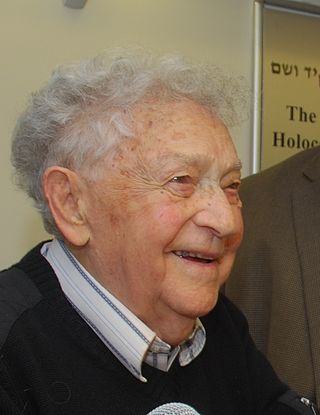
Yitzhak Arad was an Israeli historian, author, IDF brigadier general and Soviet partisan. He also served as Yad Vashem's director from 1972 to 1993, and specialised in the history of the Holocaust.

Rokiškis is a city in northeastern Lithuania with a population of about 14,400.
The history of the Jews during World War II is almost synonymous with the persecution and murder of Jews which was committed on an unprecedented scale in Europe and European North Africa. The massive scale of the Holocaust which happened during World War II greatly affected the Jewish people and world public opinion, which only understood the dimensions of the Final Solution after the war. The genocide, known as HaShoah in Hebrew, aimed at the elimination of the Jewish people on the European continent. It was a broadly organized operation led by Nazi Germany, in which approximately six million Jews were murdered methodically and with horrifying cruelty. Although the Holocaust was organized by the highest levels of the Nazi German government, the vast majority of Jews murdered were not German, but were instead residents of countries invaded by the Nazis after 1938. Of the approximately 6 million Jews murdered by the Nazis, approximately 160,000 to 180,000 were German Jews. During the Holocaust in occupied Poland, more than one million Jews were murdered in gas chambers of the Auschwitz concentration camp alone. The murder of the Jews of Europe affected Jewish communities in Albania, Austria, Belarus, Belgium, Bosnia & Herzegovina, Channel Islands, Croatia, Czech Republic, Estonia, France, Germany, Greece, Hungary, Italy, Latvia, Libya, Lithuania, Luxembourg, Moldova, the Netherlands, North Macedonia, Norway, Poland, Romania, Russia, Serbia, Slovakia, and Ukraine.

The Jäger Report, also Jaeger Report was written on 1 December 1941 by Karl Jäger, commander of Einsatzkommando 3, a death squad of Einsatzgruppe A attached to Army Group North in the Operation Barbarossa. It is the most detailed and precise surviving chronicle of the activities of one individual Einsatzkommando, and a key record documenting the Holocaust in Lithuania as well as in Latvia and Belarus.

Kudirkos Naumiestis is a town in southern Lithuania. It is located 25 km (16 mi) south-west of Šakiai.

Skala-Podilska or Skala upon Zbruch is a rural settlement in Chortkiv Raion, Ternopil Oblast, Ukraine over the Zbruch River. It hosts the administration of Skala-Podilska settlement hromada, one of the hromadas of Ukraine. Population: 4,094.

Radzanów is a village in Mława County, Masovian Voivodeship, in east-central Poland, approximately 28 kilometres (17 mi) south-west of Mława and 101 km (63 mi) north-west of Warsaw. It is the seat of the gmina called Gmina Radzanów.
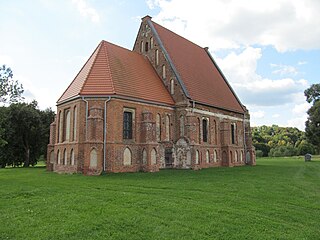
Zapyškis is a small town in Kaunas County in central Lithuania on the left bank of the Nemunas River. As of 2011 it had a population of 264.
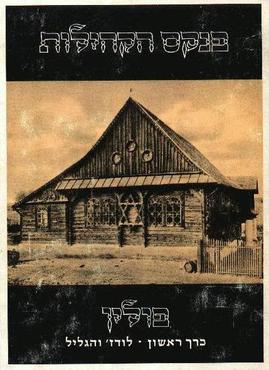
Pinkas haKehillot or Pinkas Ha-kehilot, Encyclopedia of Jewish Communities from Their Foundation till after the Holocaust, is the name of each volume of a series presenting collected historical information and demographic data on Eastern European countries' Jewish communities, most of which were depopulated and whose populations were exterminated in the Holocaust. Pinkasei haKehillot is one of the most important projects undertaken by Yad Vashem in Jerusalem, concisely documenting this aspect of the history of the Holocaust.

The Mińsk Mazowiecki Ghetto or the Mińsk Ghetto was a World War II ghetto set up by Nazi Germany in occupied Poland. Some 7,000 Polish Jews were imprisoned there from all neighbouring settlements for the purpose of persecution and exploitation. Two years later, beginning 21 August 1942 during the most deadly phase of the Holocaust in occupied Poland, they were rounded up – men, women and children – and deported to Treblinka extermination camp aboard Holocaust trains. In the process of Ghetto liquidation, some 1,300 Jews were summarily executed by the SS in the streets of Mińsk Mazowiecki.

The Nowy Sącz Ghetto known in German as Ghetto von Neu-Sandez and in Yiddish as צאנז or נײ-סאנץ was a World War II ghetto set up by Nazi Germany for the purpose of persecution and exploitation of Polish Jews in the city of Nowy Sącz pronounced[ˈnɔvɨˈsɔnt͡ʂ] during the occupation of Poland (1939–45).